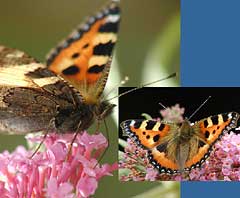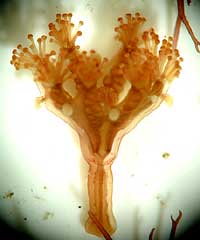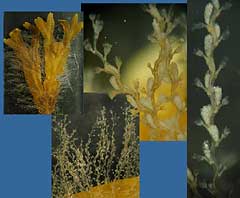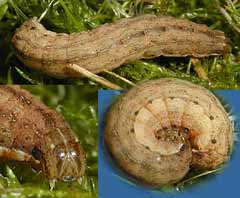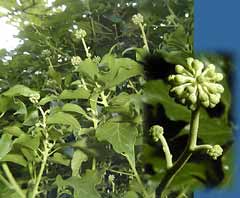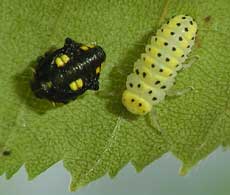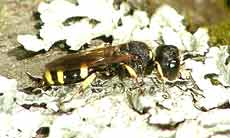Go to latest entry.....................................Go to previous entry20 August - We are back home after three glorious weeks of hiding away by the sea in the depths of Cornwall, enjoying the sunshine (except for the first four days which were very wet!) but escaping the record high temperatures experienced here at home. The hot weather has encouraged huge amounts of plant growth - I cannot see any water surface at all in the big pond today and I will need to do some clearing over the next few days. There are lots of 'new' frogs about around the edges of the pond so I will be taking some care as I cut away some of the growth. The leaf-cutter bees are still active and I've noticed that at the bee hotel several of the larger holes have been sealed up with a pink coloured 'mud'. I haven't seen this before - I wonder whether it's a sign of a different solitary bee species. Although I didn't take a lot of photographs while on holiday (too much time being spent on or in the sea), I thought that I would include a few 'holiday snaps'. Here are a couple of the more interesting sea beasts that I encountered -
I first found these last year in the same place, at the extreme low tide line during a Spring tide. During this holiday the tides did not drop quite as low and I only found a couple of individuals. Living on weed which is often the same colour as they are makes sea spiders difficult to spot but it is worth the effort.
They are described as 'suctorial feeders' and prey on the hydroids, bryozoans and even small sea anemones that live attached to the red seaweeds. This picture shows one climbing over the weed towards the bottom left of the image.
The bell of the jelly fish measured about 15cm across, so I estimate that its longest tentacles were just about 1m long. The insert on the left shows how it gets its name, with the pattern resembling the 16 points of the compass.
In the left-hand image you can see how the domed top is almost transparent. In the right-hand image you can see more detail of the underside of the creature - I need to find out more about what this shows. Notice how the tentacles and the four central, mouth bearing lobes (called manubrium) have contracted greatly compared with the free swimming individual. Hopefully I will have time to add some more images later in the day, but now the garden awaits my attention! Click on the images to see larger versions
21 August - Today I've done a bit of tidying up in the garden but more time has been spent doing some rearranging indoors. Last night I decided to start removing some of the Willowherbs that have past their prime by the big pond. My efforts came to a sudden end when, as I pulled one plant out, roots and all, a mighty buzzing could be heard from the ground - I had disturbed a bumble bee nest! I should have remembered that I had seen bee activity there a couple of months ago. Although the noise was quite loud, only a few bees emerged and it wasn't long before they quietened down again, so I hope I did not do too much damage to the nest. Today I could see bees coming and going again so it looks as though they are safe.
It must have visited every flower head during the next half hour, and didn't seem to mind my fussing round with the camera as it fed. This was in contrast to a couple of Large Whites which left as soon as I moved towards them.
The first is this stalked jellyfish (Haliclystus auricula - I think). Found in the same area as the sea spider this little creature measured about 15mm tall and was attached to seaweed until just before I took this picture.
My images are not good enough for me to identify it properly, but it is very similar to the illustration of Laomedea flexuosa shown in my seashore guide. At the end of each short 'stalk' there is a cup (hydrotheca) in which an individual (a hydranth) with tentacles feeds from particles in the surrounding water. In the two close-up images you can see bulbous white objects at the bases of some stalks. These are gonothecae, containing blastostyles which produce the sexual stage in the life-cycle of the hydroid. In the right-hand image you can just make these out. They give rise to free drifting medusae which are released into the sea and which then produce either male or female germ cells.
This is a colonial sea-squirt, probably Botryllus schlosseri. The individuals, called zooids are arranged in star like groups.
The zooids draw water in through the dark red openings (oral syphons) around the rim of the star. the opening at the centre is a communal atrial syphon though which the water is expelled. Food is filtered and the zooids breathe as the water is pumped through their body cavities. Click on the images to see larger versions
23 August - A warm, humid day has seen very little done. While I'm thinking about it, since coming home on Tuesday I didn't check my thermometers until yesterday. I have two (one liquid, one electronic) which are sited in shaded parts of the garden and which record max/min settings. Both agree on a maximum recorded temperature of 39C (101F) which must have been reached during the heatwave. A couple of days ago I mentioned noticing that several of the larger (7mm) holes in the bee hotel had been sealed with a pink coloured material. A closer look today suggests that the plug appears to be made up from chewed plant materials rather than mud. The right-hand image shows the usual appearance of a plug I have watched being produced by an Osmia sp. (or similar) bee. I haven't see any further activity at these holes this week.
This is one of those bees, apparently resting. The nearest match that I can find in my insect guides is Bombus agrorum. The total absence of pollen on it suggests that it is a newly emerged individual, although it seems to have lost one of its antennae.
This one measured about 4cm in length and was found down at ground level amongst the moss.
I haven't been able to identify either species so far. Today was another warm, largely sunny day but the weather is set to change during the next few days, according to a weather forecast that I have just seen.
These will come into flower during next month. Hopefully this will coincide with good weather so that they will attract butterflies with their strong aroma.
At the other end of the garden the many berries on the Hawthorn are now turning red. Click on the images to see larger versions
On the bird front, things are relatively quiet in the garden. The House Sparrows have returned to the feeder and the Collared Doves are very active with courtship behaviour taking place. The only Blackbird and Robin coming to feed have been juveniles, although I have heard adults singing/calling in the trees. There have been several morning attacks by a Sparrowhawk, although I haven't seen anything caught, and there is no sign of any successful attack while we were away. There have been no Dunnocks or Blue Tits seen.
25 August - A cloudy but dry day with lower temperatures (max 20C). Having mentioned the absence of Dunnocks yesterday there have been a number of visits today. Perhaps it (they?) has just realised that there is food available on the ground again. The Sparrowhawk came again and a different call had me grabbing my binos just in time to see a Greater Spotted Woodpecker on a treetop about six gardens away. A little bit earlier we had heard something tapping on wood in our neighbours garden, although I'm not sure the two things were linked.
All but one were females who were all hanging onto egg bundles (left image). The male on the left is easily distinguished from the female by the presence of the large palps.
Tomorrow may be a drastic day in the life of my garden. One of my tree surgeon sons is going to have a look at the Leylandii trees with the probability being that we will remove them completely. They are getting out of hand and increasingly difficult to prune properly. They back on to another line of conifers in adjoining properties and are more or less dead on that side because of the lack of light. On the side facing my garden the branches grow with great enthusiasm and so thay have become very unbalanced. There is very little bird activity in the trees at the moment so it seems the best time to take this step before we head into some wet weather!
27 August - Another dry day and a busy, if noisy one in the garden as the Leylandii were cut down by Adam and turned into wood chips. The tree stumps will have to wait a couple of weeks until my other tree surgeon son (Simon) has the chance to come and deal with them. I looked carefully at the branches as they came down and saw just one recent nest, probably of a blackbird. There was no sign of recent Greenfinch nests, thankfully. Over the next few months I hope to do quite a bit of work at the bottom of the garden. One priority will be to move the Blue Tit box used for my webcam to a new location and to set up the wiring so that it is ready for use by Christmas.
30 August - A very pleasant, sunny day after yesterday which saw the first 'proper' rain in many weeks. I'm not doing any work in the garden for a few days, but I have picked up my camera for the first time since removing the Leylandii. If you followed my diaries this time last year then you will have seen numerous pictures of Orange Ladybirds (Halyzia sedecimguttata) and their larvae.
I have not seen any adults yet, but he picture shows a larva (right) and a pupa clinging to the underside of a leaf on the Birch tree. It appears that the larva is in the pre-pupa stage and is likely to undergo a moult and become a pupa in the next few days. There are pictures of this change in my diary entries for the 11/13 September last year. I can see several more pupae on other leaves so I must try to get images of the adult emerging this year (a moment I missed in 2002).
At first glance it appears to be similar to the one working on a burrow in the log that I photographed back on August 19 2002, but even then I wasn't able to get a good photograph of it. I shall have to watch out for signs that this one is burrowing. Click on the images to see larger versions |
|




